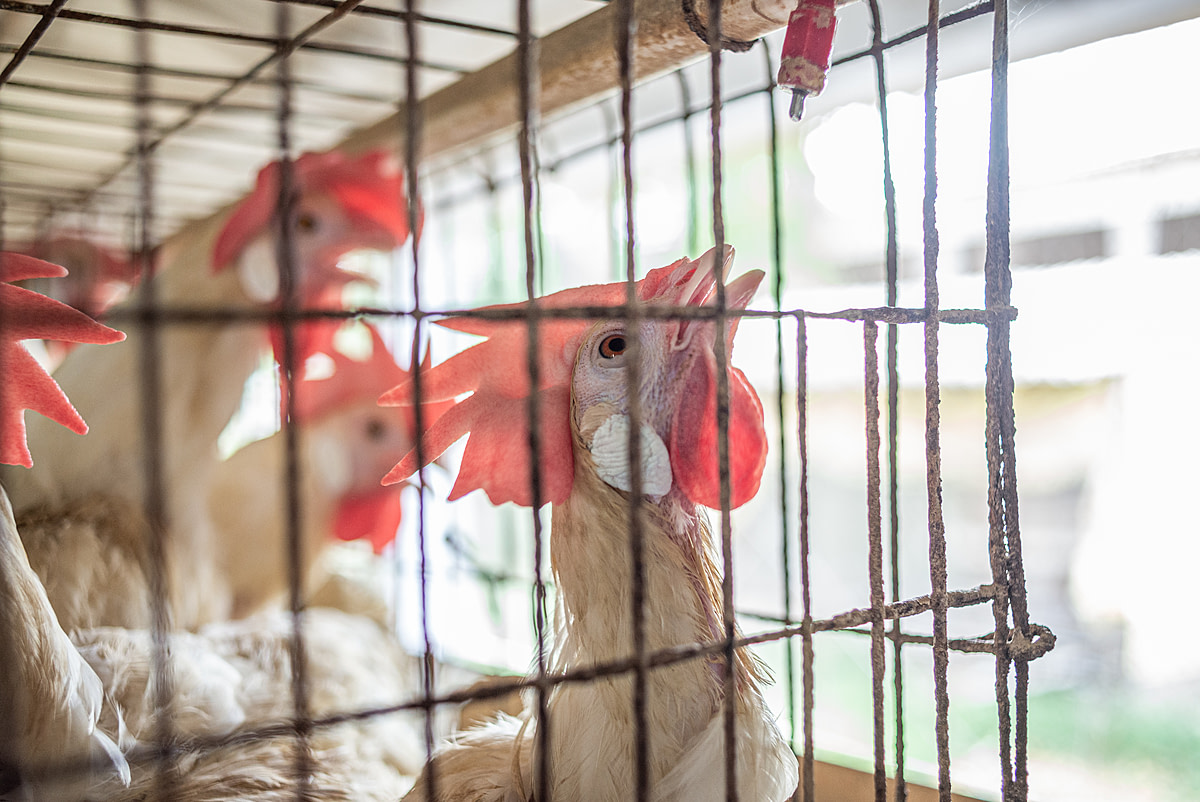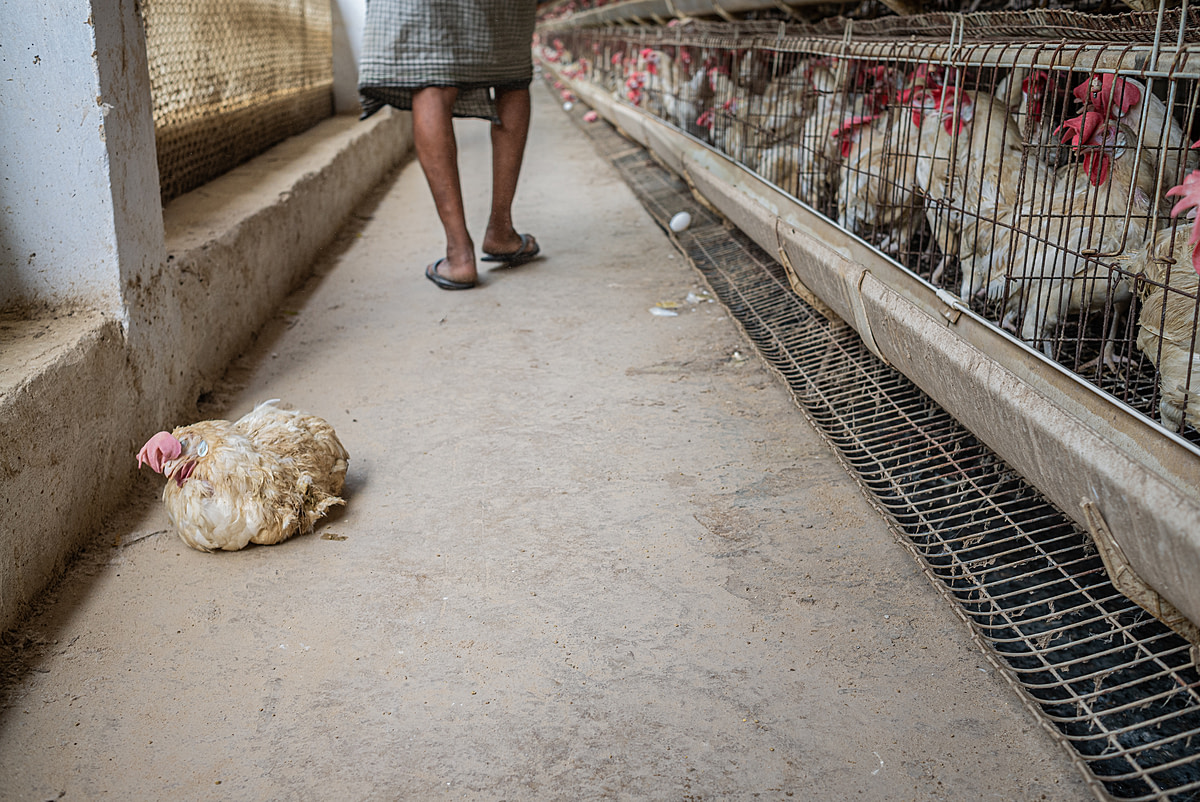Death by Heat Exhaustion: Inside India’s Poultry Farms
Photographer and Videographer: S. Chakrabarti
Author: We Animals Media
Explore and download these visuals via our stock platform.
We Animals Media photojournalist S. Chakrabarti recently documented conditions inside India’s poultry farms (egg and broiler) during the summer heatwaves, which have been increasing in frequency over the past few years as a result of climate change and shifting weather patterns. Throughout these periods death due to heat exhaustion is a regular occurrence for birds inside farms.
During India’s summer months, temperatures can easily go above 40°C. India is the third largest egg producer in the world and a leading exporter, and poultry farm sheds are often built in open fields where during the summer afternoon temperatures soar and can reach up to 48°C. In these conditions, the birds inside the sheds bear the brunt of this extreme heat. Even though some of the farms have overhead fans or standing fans, cooling the entire area is difficult, especially with regular power outages in these areas. Death due to heat exhaustion is a regular occurrence in these temperatures.
Cages have water sprinklers that are pressure activated when a hen pecks on it. Some also have a thin plastic trough placed alongside the outer part of the cages where water is released at particular times of the day. Despite these features, our photojournalist witnessed hens panting constantly and birds lying on the floor with their wings spread wide, desperately trying to cool themselves.
A hen in a battery cage pants in the heat of the day. Rows of stacked battery cages house thousands of hens inside this tin-roofed, open-sided cement shed on an intensive mid-level egg-production farm. Like all birds, hens do not sweat and must pant to cool down when they feel too hot. Though this shed has a ventilation fan at one end of the building, frequent power cuts and outside temperatures reaching 42°C (107°F) cause the hens to jostle for cooler space. India, 2023. S. Chakrabarti / We Animals Media
Both egg-laying hens and broiler birds are bought from hatcheries when they are just a few days old. These chicks are kept in an open floor shed, where they are fed constantly on a mix which includes growth hormones and a variety of medicines and supplements.
On egg farms, after 120 days, the now adult hens are shifted into cages of roughly three feet by two feet in size, in groups of up to six, balancing themselves on the thin metal wires of the floors. Our photojournalist noted that many of the hens had missing feathers and visible skin rashes. Their beaks were blunted or chipped off – this is in order to prevent injuries from attacks given their intense confinement. The hens will stay in these cages for 18 to 24 months, after which their egg production declines and they are sold to slaughterhouses.
On broiler farms, the chicks remain in open floor sheds until they reach slaughter weight, which can be as soon as four weeks. These sheds can hold between 8,000 and 15,000 chicks.
“The farm I had gone to had two main sheds – one for the adult egg laying hens and the other shed which only had younger chicks. The adult hens were placed four in a cage while the younger ones were on an open floor set up. When I was shooting in the egg laying shed, the moment I would go close to a cage, the hens would start getting scared and agitated and turn away to the other end of the small cage. There was a visible panic that would set in.
In the shed with the younger chicks, I walked and sat amongst them as there weren’t any cages. The chicks started approaching me and explored my shoes, my camera, my hands, my clothes – pecking lightly or just bobbing their heads around, inspecting me curiously. Some even came hobbling towards me similar to how puppies come running towards a new person. There was so much of an innocent trust and curiosity in them! That was such a stark contrast to how the adult hens were behaving in the cages.” ― S. Chakrabarti, animal photojournalist
Rows of battery cages are stacked up on top of each other inside tin-roofed, open-sided sheds where hot wind passes through the open sides. Each of these sheds can hold anywhere between 8,000 and 18,000 egg-laying hens. Despite confining hens to battery cages violating India’s animal welfare law, an estimated 400 million hens in the country continue to live their lives confined to such cages due to lack of government enforcement.
A tin-roofed and open-sided cement shed forms the basic structure for this mid-level intensive egg-production farm, where rows of egg-laying hens live inside tiers of battery cages. The 12,000 hens inside this shed routinely jostle for a cooler space while the outside temperature reaches 42°C (107°F). This shed has only one ventilation fan at the end of the building, no overhead fans and power outages are a regular occurrence. Birds cannot sweat and the hens must pant to cool down. India, 2023. S. Chakrabarti / We Animals Media
Young chicks drink water dripping down on the mesh wire and gunny sacks covering the open spaces of a shed on an Indian egg production farm. During summer, temperatures frequently rise above 40°C, and the chicks try to find respite from the heat in the shaded corners of the farm shed. India, 2023. S. Chakrabarti / We Animals Media
These visuals offer a glimpse into the lives of birds on poultry farms, which is a stark contrast to their natural conditions and behaviours. Instead of foraging in the dirt for insects and seeds, dust bathing and experiencing life in a flock with a social “pecking order” for anywhere up to ten years, farmed chickens are forced to endure a short but distressed life of confinement with no autonomy – systemic suffering exacerbated by intense heat waves.
“The cage became like a symbol for crushing that innocence and trust with which the younger chicks interacted with me. They had no idea that in a few weeks they would also be put in small cages for the next two years just to lay eggs and then sent to slaughterhouses once their yield becomes low.” ― S. Chakrabarti
India, 2023. S. Chakrabarti / We Animals Media
Data sources: Mercy for Animals / Pure & Eco India / British Hen Welfare Trust
Images and video clips by S. Chakrabarti.
Explore and download visuals from this assignment via our stock platform, which offers 20,000+ images and video clips for free to anyone helping animals.
Donate today and help us continue to produce compelling global investigations into these cruel industries.
More like this from We Animals Media:
Interview with Animal Photojournalist S. Chakrabarti
by We Animals Media | Mar 23, 2023
Eggs: The Unseen Story
by Kelly Guerin | Jul 28








